Review: Android 6.0 Marshmallow
Google Now On Tap
Google Now On Tap is the main feature of Android 6.0. As with many things throughout life, it's all about context. The general idea behind Now on Tap is a great one.
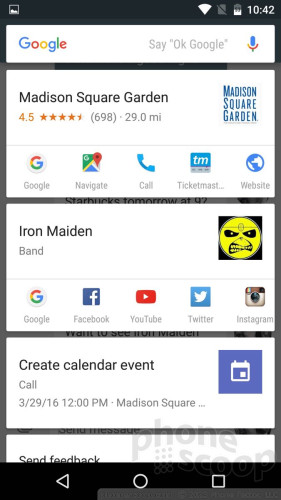
The concept is to provide the right pieces of information at just the right time, based on a number of factors. It works best in a few apps, including messaging, search, email, the browser, and other apps that include names and places. It works by taking a quick screenshot, which is sent to Google for interpretation. I was impressed by how swiftly it performed.
Let's say you're negotiating a dinner meet-up with a friend. Your friend suggests gathering at a trendy place at 8pm that's often crowded. Reservations are a good idea. A long press of the home button (while viewing the message thread) initiates Now on Tap. It thinks for a moment, and then provides a handful of potential actions. In this example, it would include everything there is to know about the restaurant in question, including Google Search results, web site, address, phone number, ratings, news, and photos. Moreover, it delivers the means to make a reservation and navigate there by tapping on the results. It will also suggest adding the date to your calendar.
Maybe you're reading an article about politics and it includes a picture of the President. Now on Tap will tell you who the President is, as well as provide links to biographical information, and current news.
If you're listening to Spotify, Now on Tap will tell you the name of the song that's playing, the album it came from, the artist who performed it, and give you links to more music by the artist on YouTube and Google Music.
I checked to see what Now on tap would deliver when watching the new Star Wars trailer. What did I get? Links to Google search, Fandango for tickets, as well as a list of the cast, and tons of information about the director, the first two trilogies, and much, much more. You get the idea.
Now on Tap definitely doesn't work everywhere in Android 6.0. I tried it all over the place, and you'll often get a "Nothing on tap here" message, with a gentle suggestion to make sure there's a movie or event or person on the screen before you try to use the feature.
Once you get over the learning curve on when/where to use it, Now on Tap definitely comes in handy. I particularly like the tap-to-call and tap-to-navigate links that are delivered in the results. It's a time-saver, for sure, but it's not quite as revelatory or wow-inducing as the initial demonstrations led us to believe.
Google also improved Google Now's ability to understand natural language requests. This is something I appreciate, because it means you can talk to your phone more like a person than like a robot. I found it to be quite good at figuring out requests and taking the appropriate action.
Sidebar -- As is evidenced by the name, Now on Tap is part of Google Now, Google's anticipatory, card-based info tool. A lot of what Google Search and Google Now can do are based on voice search. I think it is high time for Google Now to be given a personality, and even a proper name.
Apple has Siri, Microsoft has Cortana. Siri, Cortana, and Google Now all offer a similar set of functions as far as voice-based actions and queries are concerned. Siri took a big leap forward this year in iOS 9 in terms of functionality and reliability. We have yet to see what Cortana will really look like in Windows 10 Mobile, which is expected to arrive in December, but Cortana does well in Windows Phone 8.1. Siri and Cortana both have something Google Now doesn't: a personality, a persona, a wit, a voice.
I firmly believe Google Now and Now on Tap are superior to Siri and Cortana in absolute terms, but it simply is not as much fun to interact with Google's no-name, no-voice helper as it is to ask Siri outlandish questions and see how she'll respond.
Doze
Doze sounds like a rather sleepy feature (ha!), but it is second to Now on Tap in the importance factor. Doze delivers serious battery life improvements to Android under certain conditions.
Battery life continues to be a sore point for mobile devices near and far. It's often astounding how handsets with 3,000 mAh batteries will die before the end of the day. Doze is here to help. Doze uses internal sensors (motion, etc.) to intelligently determine when you're not using your device, and puts it into a deep sleep mode to save the battery. It sounds simple (and probably is). The results are real.
I tested Marshmallow on a Nexus 5. I left the phone with a 75% charge on my desk overnight. When I returned the following morning, the phone had 74% charge left. It lost a single percent of battery life over night. Previously, the same phone would lose anywhere from 10% to 12% overnight. With Doze, it had almost the same amount of power left even though it sat for 8 hours. (Google's own tests claim an average 30% increase in battery life.) After a week of testing, there's absolutely no doubt that Doze results in real battery life improvement, at least if your phone sits unused for any length of time.
For example, if you accidentally fall asleep on the couch and forget to plug your phone in for the night, you'll be safe come morning, or at least not face a totally dead phone.
Google also added something to Marshmallow to help improve battery life even when the phone is being used. This feature is called App Standby.
Similar to Doze, App Standby will put seldom-used apps into a reduced activity state to drop power consumption. Right now, most of the apps that take advantage of App Standby are Google's own. This is a feature developers need to build into their apps in order for it to work. A settings tool provides you with control over which apps are allowed to go into standby. For example, you can essentially turn off bloatware so it doesn't chew up power.
I can't say if App Standby did or did not contribute to any battery life savings on my Nexus 5, as I have a solid blend of Google-made and non-Google apps on board. Overall battery life is improved a bit, no doubt, but assessing App Standby's impact in particular is difficult.
Perhaps the best part of these features is that they function automatically. You don't have to do anything to activate them. You can also choose to turn on the battery saver tool, which crimps performance in a noticeable way, in order to conserve power.
iOS and Windows Phone have their own battery conservation tools, but Doze and App Standby are more aggressive and return better results.
Permissions
The third and final major change to Android 6.0 Marshmallow is totally without sex appeal, but it's critical. App permissions have become very important, especially when you consider how much data apps collect and send to third parties.
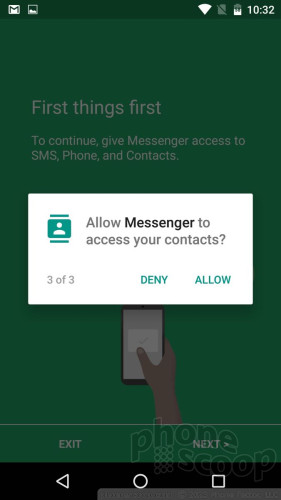
Under the old model, when people downloaded new apps the app asked them to approve their permissions in bulk immediately. The result? Everyone more or less taps "approve" without reading all the details, leaving themselves exposed to and at the mercy of whatever the developer chooses to collect. The new app permission model is dramatically different and more closely matches that of Apple's iOS.
With Marshmallow, people have control over which specific permissions are granted to which apps. Moving forward, apps ask for permission to access select features only when the use case presents itself. Take, for example, the camera. Let's say you've downloaded Facebook Messenger and you want to send a friend a photo. The first time you try snap a shot from within Messenger, a dialog box will pop up asking for permission to use the camera. You can say yes or no, and it will remember the selection for future use.
With this model, apps have fewer permissions by default, and you have to actively approve them at the appropriate moment. It may be a minor bother every now and then as you use apps, but this is much better than blindly granting access to everything when the app is first installed. This protects your privacy, and also protects you against all sorts of nasty scenarios involving malicious code.
Moreover, Marshmallow lets you grant or revoke permissions at will through the systems tools. This is a huge change, and puts Android on par with iOS in terms of user control over what apps can and cannot do while installed on your phone.
Fingerprint
Fingerprint readers have been built into Android phones for years, but they were always added by phone makers, not Google. That made it difficult for third-party apps to use fingerprints, as each phone maker and app developer had to agree on how the app would talk to that phone's fingerprint reader. That changes with Marshmallow.
Google added an API to Android 6.0 that enables fingerprint support system-wide for all Marshmallow phones. Moving forward, any app can add support for fingerprint security using Google's standard API. To highlight the feature, Google gave the Nexus 5X and Nexus 6P fingerprint readers with software called Nexus Imprint. The Imprint app manages your fingerprints for securing the phone, apps, Play Store purchases, and of course authenticating mobile payments.
This is long overdue and catches the Android platform up with what Apple's doing with TouchID.


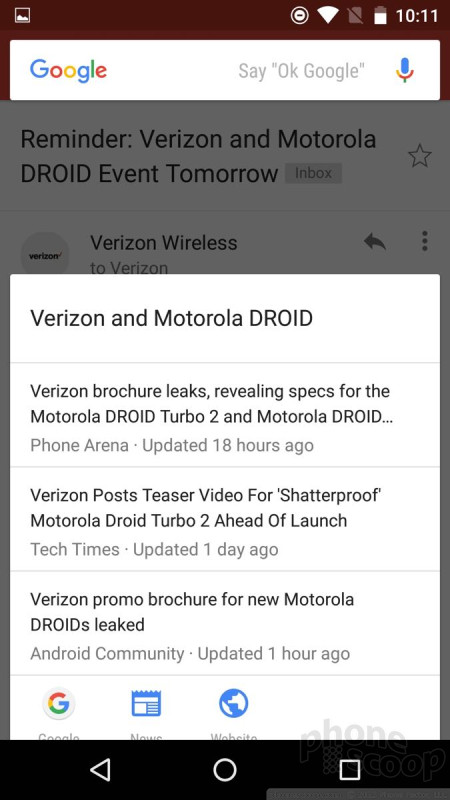









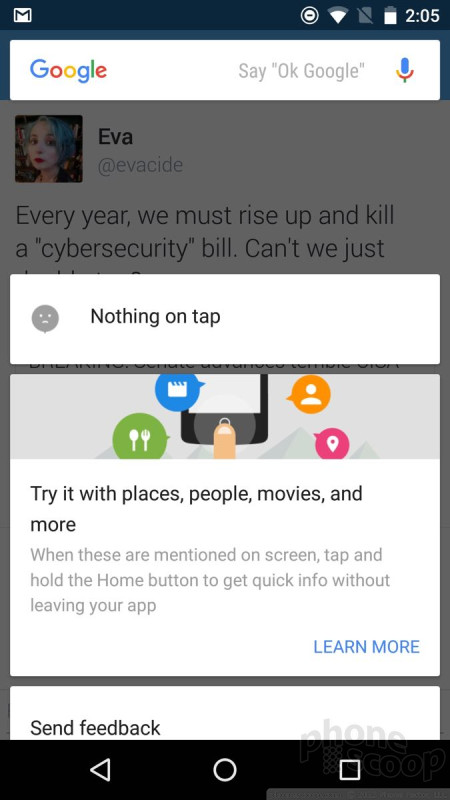



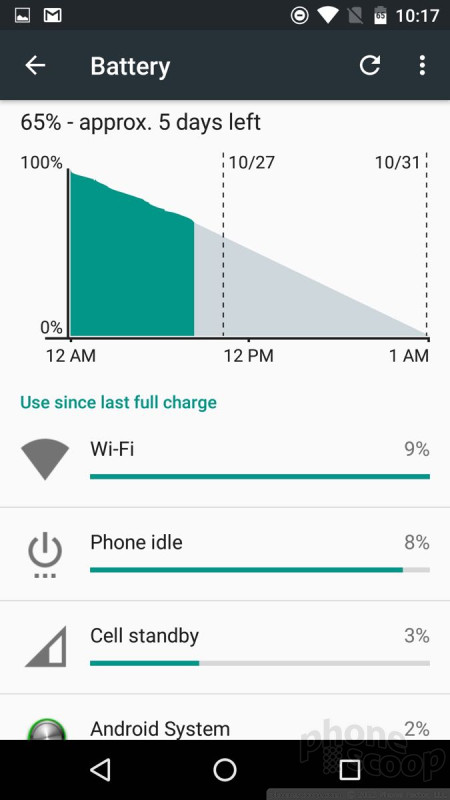



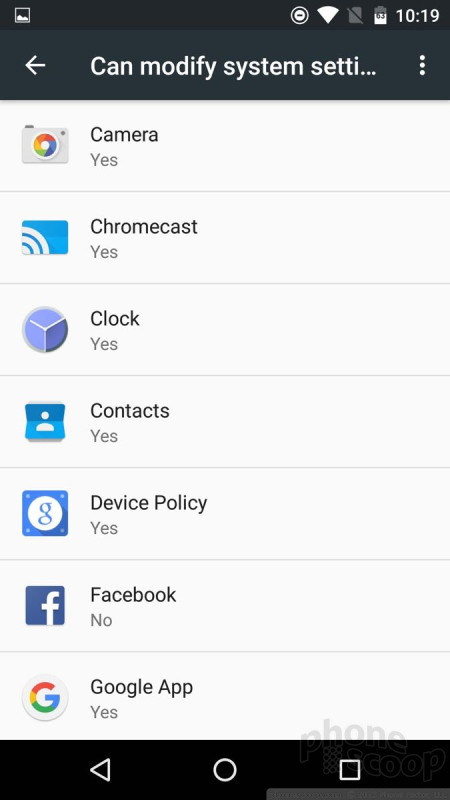







 iPhone 15 Series Goes All-In on USB-C and Dynamic Island
iPhone 15 Series Goes All-In on USB-C and Dynamic Island
 Samsung S24 Series Adds More AI, Updates the Hardware
Samsung S24 Series Adds More AI, Updates the Hardware
 Hands On with Anker's Largest "Pocket Size" Power Bank
Hands On with Anker's Largest "Pocket Size" Power Bank
 Samsung's New Foldables Stick to the Formula
Samsung's New Foldables Stick to the Formula
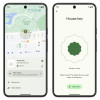 Google Launches New "Find My Device" Network
Google Launches New "Find My Device" Network









